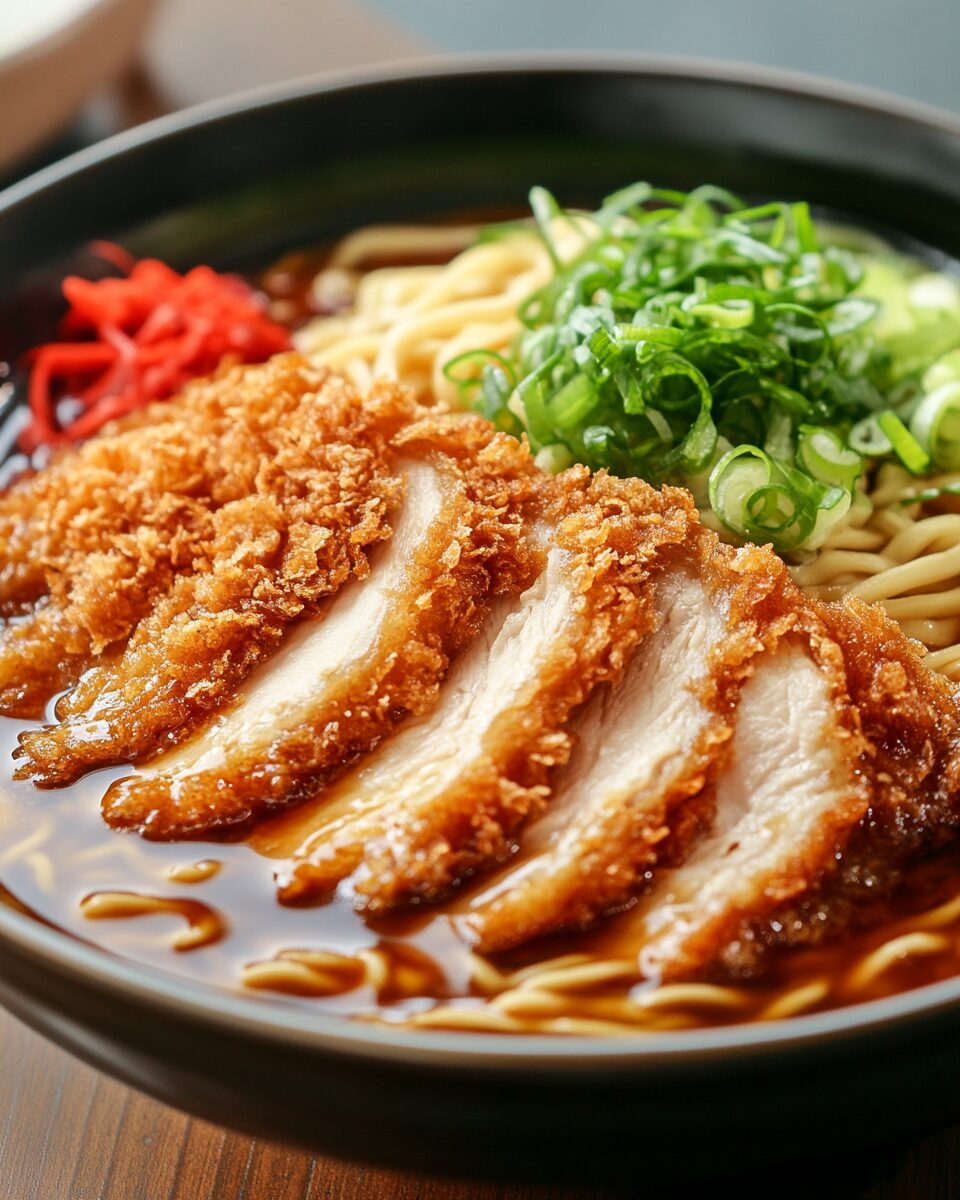Miso Ramen with Chicken Katsu is a delightful fusion of Japanese comfort food. The dish combines a savory miso-based broth with chewy noodles, fresh vegetables, and the crispy texture of chicken katsu. This warm and satisfying meal is easy to prepare in under an hour, making it an excellent choice for a cozy lunch or dinner. The balance of rich flavors and contrasting textures ensures it will be a favorite at your table.
Full Recipe:
Ingredients
For Miso Ramen:
- 1½ Tbsp oil
- 1 large shallot (sliced) or a small onion
- 3–4 garlic cloves (finely chopped)
- 1 Tbsp ginger (finely chopped)
- ½ tsp red chili flakes
- 1 cup carrots (peeled and julienned)
- 1 cup thinly sliced shiitake mushrooms
- 6 cups chicken broth
- 1 14oz can coconut milk
- 3 Tbsp soy sauce
- ¼ cup white or yellow miso paste
- 3 ramen noodle packets (seasoning discarded)
- 4–5 baby bok choy (halved)
- 1 tsp sesame oil
For Chicken Katsu:
- 2 chicken breasts (halved horizontally and pounded to ½-inch thickness)
- ½ cup all-purpose flour
- 2 large eggs (whisked)
- 2 cups panko breadcrumbs
- Salt to taste
Toppings:
- Sliced scallions
- Red chili oil
- Soft-boiled ramen eggs
Directions
Step 1: Prepare the Miso Ramen Broth
- Heat oil in a large pot over medium-high heat. Add shallots and sauté for 1 minute.
- Add ginger, garlic, and red chili flakes. Cook for another 30 seconds.
- Stir in carrots and mushrooms, cooking for 2–3 minutes until softened.
- Add chicken broth, coconut milk, and soy sauce. Whisk in miso paste until dissolved.
- Simmer for 15 minutes to meld flavors.
Step 2: Cook the Ramen Noodles
- Add ramen noodles to the broth and cook for 3–4 minutes until tender.
- Stir in sesame oil and bok choy. Cook until bok choy softens slightly.
Step 3: Make the Chicken Katsu
- Set up breading stations: one bowl with flour, another with whisked eggs, and a third with panko breadcrumbs.
- Season chicken cutlets with salt. Dredge each cutlet in flour, dip in eggs, then coat with panko breadcrumbs.
- Heat 1 inch of oil in a skillet to 350°F. Fry chicken for 8–10 minutes, flipping occasionally, until golden brown and cooked through. Drain on paper towels.
Step 4: Serve
- Divide noodles and broth into bowls.
- Slice chicken katsu and place on top of noodles.
- Garnish with scallions, chili oil, and soft-boiled eggs.
Nutritional Information
Per serving:
- Calories: 675
- Total Fat: 35g
- Carbohydrates: 50g
- Protein: 38g
- Fiber: 7g
- Sodium: 1200mg
Cultural Roots of Miso Ramen
Ramen has a long and storied history, originating in China and becoming a beloved part of Japanese cuisine over centuries. Miso ramen, a relatively modern invention from the Hokkaido region, became popular in the mid-20th century. This variation uses miso paste as the base for its broth, setting it apart from shoyu (soy sauce) and tonkotsu (pork bone) ramen varieties. Miso brings a bold, hearty flavor to the dish, making it particularly comforting during colder months.
The addition of chicken katsu, on the other hand, draws from yōshoku, a Western-influenced style of Japanese cooking that emerged during the Meiji Era (1868–1912). Dishes like tonkatsu (pork cutlets) and chicken katsu, inspired by European breaded cutlets, became staples of Japanese cuisine and have since been adapted in creative ways, such as pairing them with ramen.
The Fusion of Two Comfort Foods
The genius of pairing miso ramen with chicken katsu lies in the marriage of textures and flavors:
- The Ramen Broth: Rich, creamy, and umami-packed, it serves as a comforting base for the dish. Miso paste, combined with coconut milk, creates a silky texture and slightly sweet undertone, balancing the saltiness of soy sauce and the spice of chili flakes.
- The Chicken Katsu: Breaded and fried to perfection, the cutlet introduces a crispy contrast to the tender noodles and velvety broth. Its mild seasoning allows it to soak up the flavors of the broth without overwhelming the dish.
This combination transforms a humble bowl of ramen into a gourmet experience, appealing to both ramen enthusiasts and those seeking familiar, hearty proteins.
Versatility and Variations
One of the most exciting aspects of this dish is its adaptability. Whether you’re cooking for dietary preferences or looking to experiment, there are numerous ways to tailor the recipe:
- Vegetarian Options: Substitute the chicken broth with vegetable stock and replace chicken katsu with crispy tofu katsu or tempura vegetables. The miso-based broth remains as rich and flavorful in a vegetarian version.
- Spice Levels: Adjust the heat by increasing or reducing the red chili flakes and chili oil. Adding sliced fresh chilies or a dollop of spicy miso paste can further elevate the heat for spice lovers.
- Noodle Alternatives: While traditional ramen noodles are the preferred choice, soba, udon, or even gluten-free rice noodles can be used for variation.
- Protein Swaps: Instead of chicken, try pork katsu, shrimp tempura, or even a soft-boiled egg as the protein centerpiece.
- Garnishes: Experiment with toppings like sesame seeds, nori (seaweed), corn, or crispy garlic for added layers of flavor.
Why Miso Ramen with Chicken Katsu is Special
This dish is more than just a meal; it’s a sensory experience that appeals to all aspects of taste:
- Sight: Vibrant vegetables, golden chicken katsu, and colorful garnishes create an inviting presentation.
- Taste: The combination of salty, savory, and slightly sweet flavors creates a perfect balance.
- Texture: Each bite offers contrasting elements, from crispy chicken to tender noodles and crunchy vegetables.
- Aroma: The scent of garlic, ginger, and miso wafting from the steaming broth is as comforting as it is appetizing.
Tips for Perfect Execution
To ensure success when preparing this dish, here are some pro tips:
- Perfecting the Broth: Whisk the miso paste thoroughly to avoid clumps. Simmer the broth gently to meld the flavors without overcooking the vegetables.
- Crispy Katsu: Use panko breadcrumbs for the crispiest texture. Fry the chicken in batches to maintain the oil temperature and avoid sogginess.
- Timing: Prepare the katsu last so it remains hot and crispy when served. The broth and noodles can be kept warm while you fry the chicken.
The Essence of Miso Ramen
Ramen, a staple in Japanese cuisine, consists of wheat noodles served in a flavorful broth, accompanied by various toppings. The broth serves as the heart of the dish, with miso ramen specifically utilizing miso paste to impart a deep, savory umami taste. Miso, a fermented soybean paste, is rich in proteins, vitamins, and minerals, contributing both flavor and nutritional benefits to the broth. Incorporating ingredients like garlic, ginger, and soy sauce further enhances the complexity of the broth, creating a comforting base for the noodles.
The Appeal of Chicken Katsu
Chicken katsu, a Japanese adaptation of Western-style cutlets, features chicken breasts that are breaded with panko breadcrumbs and fried until golden brown. The use of panko results in an exceptionally crispy exterior, while maintaining a juicy and tender interior. This contrast in texture makes chicken katsu a beloved dish both in Japan and internationally. When paired with the savory miso ramen, the crispiness of the katsu adds an exciting dimension to the overall dining experience.
Preparation Insights
Creating Miso Ramen with Chicken Katsu involves several key steps:
- Miso Ramen Broth: Begin by sautéing aromatics such as shallots, garlic, and ginger to build a flavorful foundation. Adding vegetables like carrots and shiitake mushrooms introduces subtle sweetness and earthiness. The broth is then developed by combining chicken stock, coconut milk for creaminess, soy sauce, and miso paste, simmering to meld the flavors harmoniously.
- Chicken Katsu: Prepare the chicken cutlets by coating them in flour, dipping in beaten eggs, and dredging in panko breadcrumbs. Frying the cutlets at the appropriate temperature ensures a crispy crust and moist interior. Proper oil temperature is crucial to achieve the desired texture without excessive greasiness.
- Noodles and Assembly: Cook the ramen noodles until al dente and add them to the simmering broth along with baby bok choy, allowing the flavors to integrate. Serving involves placing the noodles and broth in bowls, topping with sliced chicken katsu, and garnishing with scallions, chili oil, and soft-boiled eggs to enhance both presentation and taste.
Nutritional Considerations
This dish offers a balanced nutritional profile, providing proteins from the chicken, carbohydrates from the noodles, and vitamins and minerals from the vegetables and miso. The inclusion of coconut milk adds healthy fats, while the use of fresh ingredients contributes to the overall wholesomeness of the meal. Adjusting the amount of chili oil and selecting low-sodium soy sauce can help tailor the dish to specific dietary needs.
Conclusion
Miso Ramen with Chicken Katsu exemplifies the art of combining distinct culinary elements to create a dish that is both comforting and exciting. The rich, savory broth complements the crispy chicken, while the fresh vegetables and garnishes add layers of flavor and texture. This fusion not only satisfies the palate but also showcases the versatility and depth of Japanese cuisine, making it a delightful addition to any dining repertoire.






